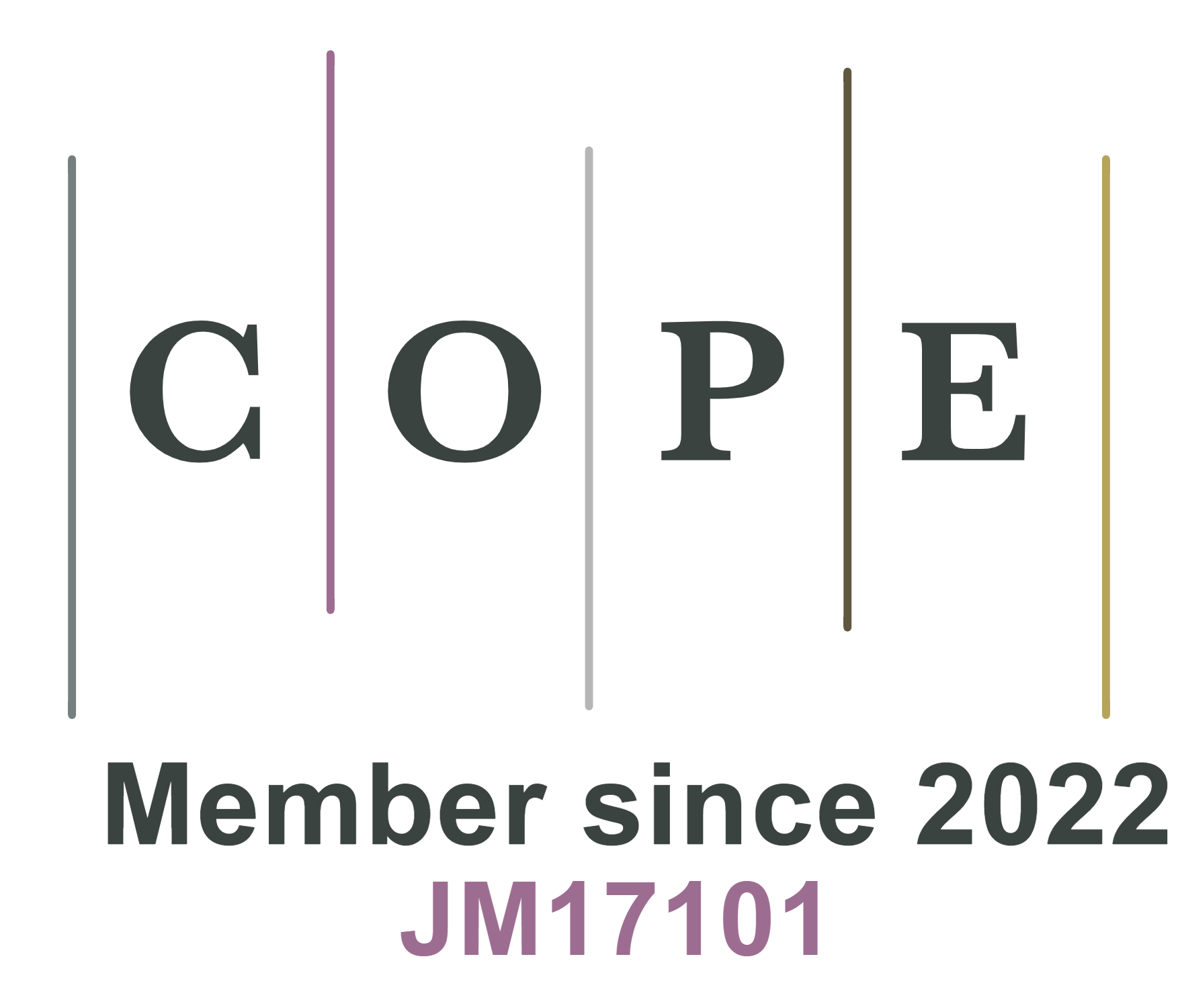NiS nanoparticle-MoS2 nanosheet core-shell spheres: PVP-assisted synthesis and efficient electrocatalyst for hydrogen evolution reaction
Abstract
The synthesis of an effective, robust, and cost-efficient electrocatalyst for H2 through water electrolysis is crucial for developing clean and sustainable energy technology. Herein, we report polyvinylpyrrolidone-assisted synthesis of NiS nanoparticle-MoS2 nanosheets core-shell (NiS@MoS2) spheres as an efficient electrocatalyst for the hydrogen evolution reaction (HER) using the hydrothermal method. The polyvinylpyrrolidone controls the size and morphology of the NiS@MoS2 sphere, and it converts into N-doped carbon (NC) as a conductive material during the calcination process to form NiS@MoS2/NC spheres. The change in MoS2 concentration (NiS@MoS2/NCx) of different catalysts significantly influences the material, size, and electrocatalytic performance. NiS@MoS2/NC50 exhibits excellent HER performance, showing a small Tafel slope of 56.7 mV dec-1 and good stability with an overpotential of 189 mV at a current density of 10 mA cm-2. HER performance is believed to be enhanced by the synergistic interaction between NiS nanoparticles and MoS2 nanosheets at the heterointerface. Furthermore, NC enhances the conductivity of the NiS@MoS2/NCx composites to enhance HER performance. Density Functional Theory simulations indicate that the best catalytic site of NiS@MoS2 is Mo, where optimal electron transfer occurs between MoS2 nanosheets and NiS nanoparticles. This electron transfer promotes H+ adsorption, reducing Gibbs free energy (ΔGH* ≈ 0.04 eV) and requiring a work function of 4.81 eV, thereby boosting HER performance. This work will open a low-cost approach for synthesis of non-precious core-shell electrocatalysts with high activity and stability for HER.
Keywords
INTRODUCTION
The rapid depletion of fossil energy resources and the decline in environmental quality have become increasingly critical challenges for both technology and modern society. Developing sustainable green energy sources is essential to address both energy crises and environmental issues. Hydrogen stands out as an ideal secondary energy source and a promising alternative to fossil fuels, offering high efficiency and non-pollution benefits[1,2]. Electrochemical water splitting is a good strategy to produce sustainable green hydrogen[3,4] due to its zero-carbon emission. This process involves two half-cell reactions: the hydrogen evolution reaction (HER) at the cathode and the oxygen evolution reaction (OER) at the anode, and thermodynamically, 1.23 V is required for the overall reaction to occur[5-7]. However, these reactions suffer from significantly large overpotential because of slow reaction kinetics during the water-splitting process[8,9]. A highly effective electrocatalyst is required to accelerate the OER and HER process to produce hydrogen from water splitting at low overpotential[10]. Platinum (Pt)-based materials are known for their high activity and effectiveness as electrocatalysts for HER[11]. Nevertheless, the limited availability and high cost of Pt-based materials have restricted their widespread use. Consequently, there is a growing focus on exploring sustainable and cost-effective electrocatalytic materials to replace precious metal-based catalysts[12,13].
In recent decades, nanostructured materials with appropriate adsorption-desorption-free energies (∆GH) have been designed to enhance water-splitting electrocatalysis. Molybdenum disulfide (MoS2) materials have attracted huge attention for hydrogen generation due to their unique electronic structure and close to zero free energy (∆GH)[14,15]. Furthermore, the exposed edges of MoS2 monolayers contain catalytic active sites, and their electronic properties facilitate the adsorption and dissociation of water molecules to release H+ and generate hydrogen gas[16]. Researchers have explored various strategies to optimize the catalytic activity of MoS2 nanomaterials for HER, including interface[17], disorder engineering[18], basal plane activation[19], hetero-atoms doping[20,21], expanded interlayer spacing[22], hybridizing with other materials[23], and designing different morphology[24]. However, the catalytic HER performance of MoS2 is suffering from a larger overpotential and still cannot be compared to that of Pt-based materials[25-27]. Recent advances in core-shell heterojunction structures have demonstrated significant potential to enhance efficiency in the HER[28,29]. These structures combine a core that provides structural integrity with a shell that improves catalytic activity and stability, optimizing charge separation, reducing recombination, and increasing active surface area. Notable examples include catalysts such as CoP@CoOOH[30] and MoS2@Ni3S2[31], which show remarkable electrochemical performance improvements due to their structural design and composition. However, challenges remain, such as stability under operational conditions, optimization of core-shell interfaces, and scalability of synthesis methods. Additionally, while noble metals are highly efficient, their high cost limits practical applications, prompting the search for more affordable alternatives such as transition metal phosphides and sulfides. Efforts are also focused on techniques such as doping to fine-tune electronic properties and further enhance catalytic activity[32,33].
MoS2-based composites have become promising candidates for exceptional HER performance. These composite materials take advantage of the catalytic capabilities of MoS2 nanomaterials and the added unique properties of the partnering materials, resulting in improved HER performance. Recently, MoS2/NiS heterojunction composite has been reported and demonstrated excellent HER performance and durability[34-36]. Chen et al. reported NiS and MoS2 nanostructure composite and optimized heterostructure material for high-performance HER activity in both acidic and alkaline environments[37]. Zhao et al. designed a heterostructure MoS2/NiS nanoflowers through precise interface modification to improve its performance in HER, which is vital for sustainable hydrogen production[38]. However, the low conductivity of the MoS2/NiS composites remains an issue during the HER process. A conductive material generally combined with MoS2/NiS materials can further improve its HER performance[39]. Guan et al. presented a scalable method for growing NiS-MoS2 hetero-nanosheet arrays on a carbon cloth and displayed outstanding HER performance due to a synergistic effect between NiS and MoS2[40]. Tao et al. synthesized NiS/MoS2 nanowire and nanoflake electrocatalysts on carbon matrix by hydrothermal-electrodeposition method and exhibited remarkable catalytic activity for HER in alkaline media[41]. Recently,
Here, we report the PVP-assisted synthesis of NiS nanoparticle-MoS2 nanosheets core-shell spheres (herein named NiS@MoS2/NCx) by hydrothermal methods and display an excellent HER performance. The PVP controlled the size of the NiS@MoS2/NC sphere and provided conductive NC support to the
EXPERIMENTAL
Materials
Nickel sulfate hexahydrate [NiSO4·6H2O (50 mg)] (99.9%) and PVP (C6H9NO) were purchased from Shanghai McLean Biochemical Technology, Ammonium molybdate (para) tetrahydrate
Synthesis of NiS@MoS2/NCx composite
Firstly, PVP (200 mg) is dispersed in distilled water by sonication for 20 min. Then, ammonium molybdate tetrahydrate (NH4)6Mo7O24·4H2O (50 mg) is added and dissolved into the PVP solution. This is followed by the dissolution of Nickel sulfate hexahydrate (NiSO4·6H2O) and thiourea CH4N2S in the reaction mixture. The mixture was placed in a Teflon-lined stainless-steel autoclave with a capacity of 30 mL and subjected to heating at 180 °C for 12 h. Once cooled, the product was retrieved through centrifugation and subsequently washed four times each with water and ethanol. The product was then dried at 50 °C for 15 h in a vacuum oven. Finally, it underwent calcination at 600 °C for 2 h. Various NiS@MoS2/NCx samples were synthesized using different quantities of (NH4)6Mo7O24·4H2O, as detailed in Supplementary Table 1, where "x" represents the amount of (NH4)6Mo7O24·4H2O used.
Synthesis of NiS@MoS2 composite
The same procedure without PVP was adopted for the synthesis of the NiS@MoS2 composite. The precursors (NH4)6Mo7O24·4H2O (50 mg), NiSO4·6H2O (50 mg), and CH4N2S (1,000 mg) were reacted together in the absence of PVP
Synthesis of MoS2/NC and NiS/NC composite
The MoS2/NC and NiS/NC composites were prepared using the same procedure. For the MoS2/NC sample, [(NH4)6Mo7O24·4H2O (50 mg)] and CH4N2S reacted in the presence of a PVP solution. In contrast, for the NiS/NC synthesis, NiSO4·6H2O and CH4N2S were used as precursors in the reaction mixture with PVP
Microstructure characterization
An X-ray powder diffractometer (XRD, Shimadzu XRD -6000) was used to characterize the crystal phases of as-prepared samples. A scanning electron microscope (SEM, FEI 250) and a transmission electron microscope [high-resolution transmission electron microscopy (HRTEM), JEOL JEM-2100F] were used to analyze the morphologies and microstructures of the materials. Energy-dispersive X-ray spectroscopy coupled with transmission electron microscopy (TEM) was used to scan the elemental mapping images. A Raman scattering spectrum was acquired at ambient temperature utilizing a Renishaw inVia Confocal Raman Microscope. A fully integrated X-ray photoelectron spectroscope (Thermo Scientific Nexsa) was used to produce X-ray photoelectron spectra (XPS). The Thermogravimetric Analysis [Pyris Diamond TG-DTA (TGA)] was used to measure weight change in the temperature range of 25 to 800 °C at the heating rate of 10 °C min-1 in air.
Electrochemical measurements
The electrochemical tests of the samples were conducted in a three-electrode system connected to the electrochemical workstation. A glassy carbon (GC), graphite rod, and Hg/HgO served as the working, auxiliary, and reference electrodes, respectively. To create a uniform ink from the synthesized catalysts and commercial 20 wt% Pt/C, 4 mg of the catalyst and 30 µL of a 5 wt% Nafion solution were sonicated in a 1:1 mixture of ethanol and deionized water (970 µL total). Subsequently, 5 µL of the resulting ink was applied to a GC electrode and left to dry in ambient conditions. Before linear sweep voltammetry (LSV), a cyclic voltammogram (CV) was performed for 20 cycles between 0 and -1.6 V vs. Hg/HgO. LSV curves were recorded in 1.0 M KOH solution at a scan rate of 5 mV s-1. The double-layer capacitance (Cdl) was assessed within a potential range of 0-0.1 V vs. Hg/HgO across varying scan rates (10-100 mV s-1) to evaluate the electrochemically active surface area (EASA) of the catalysts. The electrochemical active surface area (ECSA) normalized LSV curves of a catalyst were calculated as
where Cs is the specific capacitance of the sample in the 1M KOH electrolyte condition, with a value of
Computational approach
We employed spin-polarized DFT calculations to study the catalytic systems using Quantum ATK and visualized the structures using VESTA and VNL (version 2019.12). The aim was to simulate the core-shell architecture of NiS nanoparticles within MoS2 nanosheets. Our first step was to construct the bulk model for MoS2, followed by NiS, and finally the bulk heterojunction of NiS@MoS2. These structures are illustrated in Supplementary Figure 1.
To investigate the active sites for the HER, we carefully created surface models of MoS2, NiS, and NiS@MoS2 by cleaving them along the 001, 100, and 001 planes, respectively. The resulting surface models for HER simulations revealed that the side-on heterojunction of NiS@MoS2(001) exposes more active sites compared to the top-down heterojunction configuration. After optimization, we established slab models corresponding to MoS2(001), NiS(100), and NiS@MoS2(001), as depicted in Figure 1A.
Figure 1. (A) X-ray diffraction (XRD) patterns of the samples and (B) the Raman spectra of NiS@MoS2/NC50.
The HER activity of these models was analyzed through Gibbs free energy calculations, using DFT to evaluate the adsorption energies. For this, a single hydrogen atom was placed on the surface of MoS2(001), NiS(100), and NiS@MoS2(001) to compute the Gibbs free energy. The computational method applied the Generalized Gradient Approximation (GGA) with the Perdew-Burke-Ernzerhof (PBE) exchange-correlation functional, and a Double-Zeta Polarized (DZP) basis set was used for structure and energy optimization. The Linear Combination of Atomic Orbitals (LCAO) method was applied for Ni, Mo, S, and H atoms. A 5 × 5 × 1 Monkhorst-Pack k-point grid was utilized for structure optimization, while a 5 × 5 × 5 grid was employed for electronic property simulations.
The primary mechanism for the HER on these surfaces was evaluated using a three-state model: H+, H*, and 1/2H2. The Gibbs free energy for hydrogen adsorption (ΔGH*) is a critical parameter indicating the efficiency of an electrocatalyst. Positive ΔGH* values suggest slow hydrogen adsorption kinetics, while negative values imply slow hydrogen desorption. Ideal catalysts, such as platinum, have ΔGH* values close to zero. ΔGH* is calculated as follows:
where ΔEH* represents the energy change associated with hydrogen adsorption, ΔEZPE is the zero-point energy correction, and ΔSH is the entropy change. Room temperature (298.15 K) is used for these calculations, and the NIST database is referenced for entropy data. The relationship between free energy and hydrogen adsorption energy is given by:
where E(H*) is the energy of the surface with an adsorbed hydrogen atom, E(*) is the energy of the clean surface, and EH2 is the energy of molecular hydrogen. The simplified expression for ΔGH* is:
which represents the free energy for hydrogen adsorption and is used to assess the catalyst's effectiveness for HER.
RESULTS AND DISCUSSION
Microstructure and composition
The core-shell NiS@MoS2/NCx samples were prepared through an in-situ hydrothermal strategy as shown in Scheme 1. The dissolved Ni2+ ion is attached to the oxygen group of dispersed PVP chains due to electrostatic attraction. At elevated temperatures and high pressures, thiourea undergoes decomposition into sulfur species. The Ni2+ ions combine with the S species to nucleate and grow NiS nanoparticles[44,45]. At the same time, (NH4)6Mo7O24 reacted with S species to form layer MoS2 nanosheets around NiS nanoparticles and formed a core-shell structure. The PVP chains act as a template and stabilize nanomaterials during the growth process. The long-chain PVP provides steric repulsion between nanomaterials to keep the core-shell structure[46]. MoS2, with its intrinsic layered structure, usually forms nanosheets, leading to the core-shell morphology of NiS nanoparticle@MS2 nanosheets. During the process, PVP controls the size and morphology of the product. Furthermore, PVP can be decomposed into NC during calcination at 600 °C in inert atmosphere[47,48]. As a result, NiS@MoS2/NCx products are formed. For more details of the synthesis process, see the Section "Experimental".
The crystallinity of the as-prepared composites was characterized using XRD [Figure 1A]. The XRD pattern of as-prepared NiS/NC sample displays peaks at 18.4°, 30.1°, 32.3°, 35.7°, 40.4°, 48.7°, 50.2°, and 52.7° which correspond to crystal planes (110), (101), (300), (021), (211), (131), (410), and (401) of NiS, respectively (PDF#12-0041). When Mo and Ni precursors were used in the reaction mixture, some additional XRD patterns appeared at 14.37°, 33.32°, and 58.33°, which correspond to the crystal planes (002), (101), and (110) of 2H- MoS2 (PDF#37-1492), respectively. These peaks are more prominent in the sample using high concertation Mo precursor in the reaction mixture [Figure 1A]. This suggests that more MoS2 nanosheets formed in the composites using high-concentration Mo precursor. The peak of pure MoS2 nanosheets shifted from 14.37° to a lower angle of about 12.08° compared to the bulk MoS2; this indicates expanding the interlayer spacing of as-prepared MoS2 nanosheets[49]. The XRD pattern of NC is not discernible in all samples, which may be attributed to the amorphous nature inherent in carbon materials.
The Raman spectrum [Figure 1B] shows the structural characteristics of NiS@MoS2/NC50. There are two characteristic peaks at 1,360 and 1,582 cm-1, which can be assigned to the G and D‐bands of carbon materials, respectively[50]. The peaks at 400 and 376 cm-1 are related to out-of-plane optical vibrations (A1g) and in-plane optical (E12g) of MoS2 nanosheets, respectively. The peaks at 441 and 278 cm-1 can be associated with E1g and A1g active vibration modes of Ni‐S and provide unsaturated Mo-S edge sites in the composite[8,42,51].
SEM images of NiS@MoS2/NC50 composite are shown in Figure 2A and B. The uniform microsphere materials can be observed, and some are agglomerated [Figure 2A]. The surface of the sphere appeared to be a hierarchical nanosheets-like structure [Figure 2B]. The average size of these spheres is around 101.4 nm after the measurement of more than 70 microspheres and the histogram of size distribution is shown in Supplementary Figure 2. The morphology of other samples NiS@MoS2/NC25
Figure 2. SEM images of (A and B) the NiS@MoS2/NC50, (C and D) NiS@MoS2, and (E and F) NiS/NC composites.
The TEM images of the sample [Figure 3A-E] showcase its hierarchical structure. As shown in Figure 3A, the sample consists of hierarchical microspheres, with some appearing agglomerated. Each microsphere comprises a dense black core surrounded by a transparent shell, as highlighted in Figure 3B. Figure 3C demonstrates a clear interface between NiS and MoS2, confirming the successful formation of the heterojunction structure. The shell comprises lamellar nanosheets, while the microsphere's core contains nanoparticles, as indicated by the white arrows in Figure 3D. Furthermore, some non-lamellar materials, likely NC, are visible in the shell [yellow arrow, Figure 3D], resulting from the conversion of PVP during calcination.
Figure 3. (A and B) TEM and (C-E) HRTEM images of the NiS@MoS2/NC50 composite. (F) The dark-field TEM image of the NiS@MoS2/NC50 sample (G-L) and the subsequent EMI of (G) Mo, (H) Ni, (I) S, (J) C, (K) N, (L) O.
The HRTEM image in Figure 3E provides additional crystallographic insights, revealing an interlayer spacing of 0.62 nm, corresponding to the (002) planes of the MoS2 nanosheets. The nanoparticle lattice fringes measure approximately 0.27 nm, corresponding to the (300) crystal plane of NiS.
Figure 3F shows the dark-field TEM image, and Figure 3G-L displays elemental mapping images of the NiS@MoS2/NC50 composite. A stronger Ni signal can be observed in the core of the microsphere, while Mo is mostly distributed in the shell area. The S element signal is stronger in the shell and weaker in the core. The C and N elements are uniformly distributed in the microsphere. These elemental mapping images further revealed the core-shell structure of NiS and MoS2 in which the NC was distributed. The rise in the O signal may be due to slight oxidation of the composite and/or absorbed water molecules [Figure 3G-L]. The elemental composition determined by energy dispersive X‐ray spectrometry (EDS) mapping reveals the following percentages: Mo (10.37%), Ni (6.36%), S (25.66%), C (42.82%), N (2.91%), and O (9.87%). Consequently, the stoichiometric ratio is calculated as 1:0.6:2.5:4.1:0.3:0.9.
For a more precise determination of NC in composite material, the TGA test was measured from 25 to
The surface chemical composition and valence state of elements in NiS@MoS2/NCx were analyzed by XPS. The survey XPS spectra of NiS@MoS2/NCx composites are shown in Supplementary Figure 7A. Survey XPS spectra of NiS@MoS2/NC50 composite reveal the presence of Ni, Mo, S, C, N, and O elements. The NiS/NC sample comprises Ni, S, C, N, and O, while the MoS2/NC catalyst contains Mo, S, C, N, and O elements.
The characteristic peaks of Mo 3d in Figure 4A, derived from the high-resolution spectrum of the NiS@MoS2/NC50 composite, are observed at 231.1 and 227.97 eV. These peaks correspond to Mo 3d3/2 and Mo 3d5/2, respectively, indicating the presence of Mo4+[43,54]. The binding energies of Mo 3d3/2 and Mo 3d5/2 are 230.95 and 227.80 eV, respectively, in the MoS2/NC sample. The peaks at 235.17 and 234.08 eV in MoS2/NC and NiS@MoS2/NC50 are associated with Mo 3d3/2 and Mo 3d5/2, indicating the existence of the Mo6+ oxidation state and suggesting the partial oxidation of the MoS2 surface[55]. These peaks are either very small or absent in the NiS@MoS2/NC50 composite, revealing reduction of Mo6+ to Mo4+ oxidation state of the MoS2 nanosheets in composites. However, the binding energy peaks of Mo4+ species in NiS@MoS2/NC50 composite shift to slightly higher energy compared to the MoS2/NC sample, indicating electron loss from MoS2.
Figure 4. High-resolution XPS spectra of (A) Mo 3d, (B) Ni 2p, (C) S 2p, and (D) C 1s for the NiS@MoS2/NC50, MoS2/NC and NiS/NC complexes, respectively.
The presence of a small peak at 225.23 eV represents the existence of S 2s[56-58]. The high-resolution XPS spectrum of the Ni 2p region of NiS@MoS2/NC50 composite exhibits a high-energy band Ni 2p1/2 at 871.96 and 874.64 eV and a low-energy band Ni 2p3/2 at 853.84 and 856.70 eV corresponding to Ni2+ and Ni3+, respectively[59,60], while for NiS/NC sample, binding energy peaks are observed at 871.82 and 874.59 eV for Ni 2p1/2, and at 854.01 and 856.75 eV for Ni 2p3/2 [Figure 4B]. The peaks around 880.20 and 862.19 eV can be related to the satellite of Ni 2p. The binding energy of the NiS/NC shifted slightly to low energy compared to NiS@MoS2/NC50. Additionally, the area of Ni2+ peaks in the NiS/NC sample is much larger than the NiS@MoS2/NC50 composite, while the opposite is true for Ni3+ ions. The XPS spectrum of S 2p can be deconvoluted into spin-orbit doublets, with peaks observed at binding energies of 161.48 and
Electrocatalytic performance toward HER
An effective electrocatalyst delivers a low overpotential (η) at a specific current density (J)[60]. HER performance of the as-prepared NiS@MoS2/NCx samples and commercial 20% Pt/C was investigated in
Figure 5. (A) The LSV curves of the commercial Pt/C and NiS@MoS2/NCx catalysts, (B) the Tafel plots estimated from LSV graph. (C) The Nyquist plots of the samples and the corresponding circuit in the inset of ‘‘C”. (D) Potential (V vs. HER) at a 10 mA cm-2 current density of the NiS@MoS2/NC50 catalyst before and after 1,000-5,000 CV cycles and the chronoamperometric curve shown in the inset of ‘‘D”.
The Tafel plots are derived from LSV curves to study the reaction kinetics and mechanism of the catalysts. The Pt/C exhibits the smallest Tafel slope of 35.14 mV dec-1. Among the as-prepared samples, the Tafel slope of the NiS@MoS2/NC50 sample is 56.67 mV dec-1, smaller than those of NiS@MoS2/NC100, NiS@MoS2/NC75, NiS@MoS2/NC25, NiS@MoS2, NiS/NC, MoS2/NC electrocatalysts while being close to that of Pt/C
The electrochemical surface area (ECSA) of various samples was determined by measuring the electrochemical Cdl. This was achieved by conducting CV within a non-Faradaic region at varying scan rates ranging from 10 to 100 mV/s, as illustrated in Supplementary Figure 8A-G. All the
The EIS [Figure 5C] tests were conducted to assess the catalytic activity at the electrode/electrolyte interface. The samples showed potential in the HER catalysis when the EIS revealed low charge-transfer resistance. The Nyquist plots are analyzed using the equivalent circuit depicted in Figure 5C. The charge transfer resistance (Rct) of NiS@MoS2/NC100, NiS@MoS2/NC75, NiS@MoS2/NC50, NiS@MoS2/NC25, NiS@MoS2, NiS/NC and
Another crucial factor for evaluating the performance of an electrocatalyst is stability [Figure 5D]. NiS@MoS2/NC50 was used to observe its stability by CV. The LSV curves of NiS@MoS2/NC50 catalysts before and after various cycles are shown in Supplementary Figure 10. The material required a slightly high overpotential at a current density of 10 mV cm-2 after 1,000, 2,000, 3,000, 4,000, and 5,000 CV cycles.
Supplementary Figure 10A shows almost negligible degradation of the composite after CV cycles. The continuous CV scanning and chronoamperometry response were also executed to further assess the durability of the as-prepared NiS@MoS2/NC50. As shown in Supplementary Figure 10B, after the stability test, the NiS@MoS2/NC50 electrode almost retains the initial activity, suggesting splendid electrochemical durability. XRD patterns of NiS@MoS2/NC50 composites before and after 5,000 CV are shown in Supplementary Figure 11. The main peaks of MoS2 and NiS phases can be seen in the XRD pattern, and no obvious changes are observed [Supplementary Figure 11]. The SEM images confirmed the microsphere morphology of NiS@MoS2/NC50 before and after 5,000 CV cycles [Supplementary Figure 12]. However, the nanosheets are not as clear and obvious compared to the fresh NiS@MoS2/NC50 sample. Furthermore, TEM images of the sample display a hierarchical microsphere-like structure, and some of them are agglomerated. It can be seen as a dense black center and transparent periphery [Supplementary Figure 13]. These results indicate that the sample is a highly stable catalyst for electrochemical HER performance in an alkaline environment. Moreover, the amperometry test was measured to further assess the durability of the NiS@MoS2/NC50. The amperometry curve (inset of Figure 5D) indicates that the current density of NiS@MoS2/NC50 exhibits a negligible decay after continuous electrolysis for 50 h at an applied potential, further revealing the superior HER stability. The LSV curves of NiS@MoS2/NC50 before and after the amperometry test almost show the same HER catalytic activity.
First-principle density functional theory simulations
First-principles DFT simulations were used to investigate the HER performance of NiS@MoS2, NiS, and MoS2. These simulations examined the free energy of hydrogen adsorption (ΔGH*) of Mo, Ni, and S elements active sites in different NiS@MoS2, NiS, and MoS2 catalysts and identified the highest active site in these materials (Figure 6A and calculation details in the Section "Computational approach"). The results revealed that NiS@MoS2 has significantly better HER performance compared to NiS and MoS2 due to optimal charge transfer within the heterojunction. Specifically, the ΔGH* values on sulfur sites for MoS2 and NiS are -1.760 and -1.95 eV, respectively. However, in NiS@MoS2, the ΔGH* values on sulfur are -0.19 and 0.52 eV bonded with Mo and Ni sites, indicating that this structure has a more favorable energy profile for HER.
Figure 6. (A) Gibbs free energy diagram of hydrogen adsorption on active sites of MoS2, NiS, and NiS@MoS2 (B), and EDD of MoS2, NiS, and NiS@MoS2 samples.
Additionally, the ΔGH* values for hydrogen evolution at metal sites in MoS2, NiS, and NiS@MoS2 were 1.12,
The Electron localization function (ELF) maps [Figure 6B] indicate that the NiS@MoS2 surface is more electron-rich compared to pristine MoS2 and NiS, suggesting electron interaction between Ni and Mo in the NiS@MoS2 composites [Supplementary Figure 14]. The electron difference density (EDD) analysis shows that the NiS@MoS2 composite has an optimal electron distribution, supporting its catalytic efficiency. Pristine MoS2 has low EDD, leading to weaker hydrogen adsorption, while NiS, with high EDD, has strong hydrogen adsorption (ΔGH* = -2.94 eV).
Furthermore, Density of states (DOS) plots in Figure 7A-C show that the valence and conduction bands in MoS2 are separated by a bandgap, while it has a narrower bandgap. In NiS@MoS2 composites, strong hybridization of bonding and antibonding orbitals results in the disappearance of the bandgap, promoting efficient charge transfer and increased stability. This charge transfer leads to a decrease in work function from 6.41 eV in MoS2 to 4.81 eV in NiS@MoS2, as shown in the effective potential plot [Figure 7D]. The local dipole generated by this charge transfer, especially at the Mo site, enhances chemical reactivity in the interface region of NiS@MoS2 composite, resulting in an ideal ΔGH* value of 0.04 eV. Overall, the DFT simulations confirm that enhanced HER activity of NiS@MoS2 composite can be attributed to the strong interaction between NiS nanoparticles and MoS2 nanosheets and charge transfer characteristics of
CONCLUSION
In conclusion, a NiS@MoS2/NC core-shell microsphere was effectively synthesized as a high-performance electrocatalyst for HER through the hydrothermal method. The morphology and size of the
DECLARATIONS
Acknowledgments
We would like to thank the National Natural Science Foundation of China (under research grant no. 22150410332) and the start-up foundation for the introduction of talent at Jiangsu University of Science and Technology, China. We also acknowledge the Faculty of Environment, Science and Economy, University of Exeter, UK, and funding support from the Engineering and Physical Sciences Research Council (EPSRC). Additionally, we appreciate the use of the University of Exeter’s Advanced Research Computing facilities (Athena HPC Cluster) for this work and for the provision of QuantumATK_2019.12 software. For the purpose of open access, the authors have applied a Creative Commons Attribution (CC BY) license to any Author Accepted Manuscript version arising from this work.
Authors’ contributions
Data curation, writing - original draft: Obiang Nsang, G. E.
Data curation, visualization: Ullah, B.
Visualization, investigation: Hua, S.; Dike, F. N.
Supervision, conceptualization, revised draft, methodology: Shah, S. A.
Methodology: Khan, N.
Visualization: Ullah, N. (Nabi Ullah); Ullah, N. (Noor Ullah)
Visualization, review draft: Yaseen, W.
Supervision, review & editing: Yuan, A.
DFT simulations, supervision, review & editing, validation: Ullah, H.
Availability of data and materials
The data is available upon request from the authors.
Financial support and sponsorship
The funding from the the National Natural Science Foundation of China (under research grant no. 22150410332) and the start-up foundation for the introduction of talent at Jiangsu University of Science and Technology, China, The Faculty of Environment, Science and Economy, University of Exeter, UK and funding support from the Engineering and Physical Sciences Research Council (EPSRC).
Conflicts of interest
All authors declared that there are no conflicts of interest.
Ethical approval and consent to participate
Not applicable.
Consent for publication
Not applicable.
Copyright
© The Author(s) 2025.
Supplementary Materials
REFERENCES
1. Morales-Guio, C. G.; Stern, L. A.; Hu, X. Nanostructured hydrotreating catalysts for electrochemical hydrogen evolution. Chem. Soc. Rev. 2014, 43, 6555-69.
2. Ďurovič, M.; Hnát, J.; Bouzek, K. Electrocatalysts for the hydrogen evolution reaction in alkaline and neutral media. A comparative review. J. Power. Sources. 2021, 493, 229708.
3. Shang, X.; Tang, J.; Dong, B.; Sun, Y. Recent advances of nonprecious and bifunctional electrocatalysts for overall water splitting. Sustain. Energy. Fuels. 2020, 4, 3211-28.
4. Li, X.; Zhao, L.; Yu, J.; et al. Water splitting: from electrode to green energy system. Nanomicro. Lett. 2020, 12, 131.
5. Ahmed, I.; Biswas, R.; Iqbal, M.; Roy, A.; Haldar, K. K. NiS/MoS2 anchored multiwall carbon nanotube electrocatalyst for hydrogen generation and energy storage applications. ChemNanoMat 2023, 9, e202200550.
6. Mistry, K.; Jalja; Lakhani, R.; Tripathi, B.; Shinde, S.; Chandra, P. Recent trends in MXene/Metal chalcogenides for electro-/photocatalytic hydrogen evolution reactions. Int. J. Hydrogen. Energy. 2022, 47, 41711-32.
7. Shah, S. A.; Shen, X.; Xie, M.; et al. Nickel@Nitrogen-doped carbon@MoS2 nanosheets: an efficient electrocatalyst for hydrogen evolution reaction. Small 2019, 15, e1804545.
8. Liu, G.; Thummavichai, K.; Lv, X.; et al. Defect-rich heterogeneous MoS2/rGO/NiS nanocomposite for efficient pH-universal hydrogen evolution. Nanomaterials 2021, 11, 662.
9. Lin, J.; Wang, P.; Wang, H.; et al. Defect-rich heterogeneous MoS2/NiS2 nanosheets electrocatalysts for efficient overall water splitting. Adv. Sci. 2019, 6, 1900246.
10. Zhang, J.; Wang, Y.; Cui, J.; et al. In-situ synthesis of carbon-coated β-NiS nanocrystals for hydrogen evolution reaction in both acidic and alkaline solution. Int. J. Hydrogen. Energy. 2018, 43, 16061-7.
11. Zheng, J.; Sheng, W.; Zhuang, Z.; Xu, B.; Yan, Y. Universal dependence of hydrogen oxidation and evolution reaction activity of platinum-group metals on pH and hydrogen binding energy. Sci. Adv. 2016, 2, e1501602.
12. Strmcnik, D.; Lopes, P. P.; Genorio, B.; Stamenkovic, V. R.; Markovic, N. M. Design principles for hydrogen evolution reaction catalyst materials. Nano. Energy. 2016, 29, 29-36.
13. Han, N.; Zhang, X.; Zhang, C.; et al. Lowering the kinetic barrier via enhancing electrophilicity of surface oxygen to boost acidic oxygen evolution reaction. Matter 2024, 7, 1330-43.
14. Hua, W.; Sun, H.; Xu, F.; Wang, J. A review and perspective on molybdenum-based electrocatalysts for hydrogen evolution reaction. Rare. Met. 2020, 39, 335-51.
15. Qin, Q.; Chen, L.; Wei, T.; Liu, X. MoS2/NiS yolk-shell microsphere-based electrodes for overall water splitting and asymmetric supercapacitor. Small 2019, 15, e1803639.
16. Koh EW, Chiu CH, Lim YK, Zhang Y, Pan H. Hydrogen adsorption on and diffusion through MoS2 monolayer: first-principles study. Int. J. Hydrogen. Energy. 2012, 37, 14323-8.
17. Liu, Q.; Fang, Q.; Chu, W.; et al. Electron-doped 1T-MoS2 via interface engineering for enhanced electrocatalytic hydrogen evolution. Chem. Mater. 2017, 29, 4738-44.
18. Xie, J.; Zhang, J.; Li, S.; et al. Controllable disorder engineering in oxygen-incorporated MoS2 ultrathin nanosheets for efficient hydrogen evolution. J. Am. Chem. Soc. 2013, 135, 17881-8.
19. Kim, Y.; Jackson, D. H. K.; Lee, D.; et al. In situ electrochemical activation of atomic layer deposition coated MoS2 basal planes for efficient hydrogen evolution reaction. Adv. Funct. Mater. 2017, 27, 1701825.
20. Geng, S.; Liu, Y.; Yu, Y. S.; Yang, W.; Li, H. Engineering defects and adjusting electronic structure on S doped MoO2 nanosheets toward highly active hydrogen evolution reaction. Nano. Res. 2020, 13, 121-6.
21. Meng, X.; Yu, L.; Ma, C.; et al. Three-dimensionally hierarchical MoS2/graphene architecture for high-performance hydrogen evolution reaction. Nano. Energy. 2019, 61, 611-6.
22. Sun, Y.; Alimohammadi, F.; Zhang, D.; Guo, G. Enabling colloidal synthesis of edge-oriented MoS2 with expanded interlayer spacing for enhanced HER catalysis. Nano. Lett. 2017, 17, 1963-9.
23. Li, W.; Zhang, Z.; Zhang, W.; Zou, S. MoS2 nanosheets supported on hollow carbon spheres as efficient catalysts for electrochemical hydrogen evolution reaction. ACS. Omega. 2017, 2, 5087-94.
24. Zhang, X.; Hua, S.; Lai, L.; et al. Strategies to improve electrocatalytic performance of MoS2-based catalysts for hydrogen evolution reactions. RSC. Adv. 2022, 12, 17959-83.
25. Li, Z.; Xu, Y.; Ren, X.; Wang, W. Facile synthesis of NiS2-MoS2 heterostructured nanoflowers for enhanced overall water splitting performance. J. Mater. Sci. 2020, 55, 13892-904.
26. Xu, X.; Zhong, W.; Zhang, X.; et al. Flexible symmetric supercapacitor with ultrahigh energy density based on NiS/MoS2@N-rGO hybrids electrode. J. Colloid. Interface. Sci. 2019, 543, 147-55.
27. Zhang, D.; Jin, Y.; Cao, Y. Facile synthesis and ammonia gas sensing properties of NiO nanoparticles decorated MoS2 nanosheets heterostructure. J. Mater. Sci. Mater. Electron. 2019, 30, 573-81.
28. Zhao, X.; Ran, W.; Wang, Z.; Sun, J.; Liu, R.; Liu, J. Dynamic monitoring of the structural evolution of Au@Pd under electrochemistry. J. Phys. Chem. C. 2023, 127, 5432-41.
29. Jiao, J.; Yang, W.; Pan, Y.; et al. Interface engineering of partially phosphidated Co@Co-P@NPCNTs for highly enhanced electrochemical overall water splitting. Small 2020, 16, e2002124.
30. Zhang, B.; Shan, J.; Wang, W.; Tsiakaras, P.; Li, Y. Oxygen vacancy and core-shell heterojunction engineering of anemone-like CoP@CoOOH bifunctional electrocatalyst for efficient overall water splitting. Small 2022, 18, e2106012.
31. Gao, Y.; Zhang, D.; Li, J.; et al. The core/shell structure P doped MoS2@Ni3S2 nanorods array for high current density hydrogen evolution in alkaline and acidic electrolyte. Chemistry 2022, 28, e202202410.
32. Kobayashi, Y.; Yokoyama, S.; Shoji, R. Molten salt synthesis of intermetallic compound TiNi nanopowder passivated by TiOx shell prepared from NiTiO3 for catalytic hydrogenation. Materials 2022, 15, 8536.
33. Wang, H.; Jiao, S.; Liu, S.; et al. Mesoporous bimetallic Au@Rh core-shell nanowires as efficient electrocatalysts for pH-universal hydrogen evolution. ACS. Appl. Mater. Interfaces. 2021, 13, 30479-85.
34. Wang, H.; Tian, L.; Zhao, X.; Ali, M.; Yin, K.; Xing, Z. In situ growth MoS2/NiS composites on Ni foam as electrode materials for supercapacitors. Mater. Today. Commun. 2023, 34, 105041.
35. Tang, C.; Zhang, H.; Xu, K.; et al. Scalable synthesis of heterostructure molybdenum and nickel sulfides nanosheets for efficient hydrogen generation in alkaline electrolyte. Catal. Today. 2018, 316, 171-6.
36. Yin, M.; Zhang, W.; Qiao, F.; Sun, J.; Fan, Y.; Li, Z. Hydrothermal synthesis of MoS2-NiS/CdS with enhanced photocatalytic hydrogen production activity and stability. J. Solid. State. Chem. 2019, 270, 531-8.
37. Chen, Z.; Liu, X.; Xin, P.; et al. Interface engineering of NiS@MoS2 core-shell microspheres as an efficient catalyst for hydrogen evolution reaction in both acidic and alkaline medium. J. Alloys. Compd. 2021, 853, 157352.
38. Zhao, X.; Bao, J.; Zhou, Y.; et al. Heterostructural MoS2/NiS nanoflowers via precise interface modification for enhancing electrocatalytic hydrogen evolution. New. J. Chem. 2022, 46, 5505-14.
39. Patil, P. A.; Khalate, S. A.; Patil, U. M.; Kale, R. D.; Kulkarni, S. B. Cavity structured S-NiO with improved energy density for aqueous asymmetric hybrid supercapacitors by CDA mechanism. Mater. Adv. 2023, 4, 4607-19.
40. Guan, S.; Fu, X.; Lao, Z.; Jin, C.; Peng, Z. NiS-MoS2 hetero-nanosheet arrays on carbon cloth for high-performance flexible hybrid energy storage devices. ACS. Sustain. Chem. Eng. 2019, 7, 11672-81.
41. Tao, K.; Gong, Y.; Lin, J. Low-temperature synthesis of NiS/MoS2/C nanowires/nanoflakes as electrocatalyst for hydrogen evolution reaction in alkaline medium via calcining/sulfurizing metal-organic frameworks. Electrochim. Acta. 2018, 274, 74-83.
42. Liu, Y.; Li, Q.; Zhu, Y.; et al. One-step synthesis of MoS2/NiS heterostructures with a stable 1T phase for an efficient hydrogen evolution reaction. Dalton. Trans. 2023, 52, 8530-5.
43. Ali, S. S.; Sayyar, R.; Xu, L.; et al. In-situ synthesis of NiS2 nanoparticles/MoS2 nanosheets hierarchical sphere anchored on reduced graphene oxide for enhanced electrocatalytic hydrogen evolution reaction. J. Colloid. Interface. Sci. 2022, 624, 150-9.
44. Lunk, H.; Hartl, H. Discovery, properties and applications of molybdenum and its compounds. ChemTexts 2017, 3, 48.
45. Luo, W.; Zhang, G.; Cui, Y.; et al. One-step extended strategy for the ionic liquid-assisted synthesis of Ni3S4-MoS2 heterojunction electrodes for supercapacitors. J. Mater. Chem. A. 2017, 5, 11278-85.
46. Jian, G.; Zhang, C.; Yan, C.; Moon, K.; Wong, C. P. Scalable preparation of fully coated Ag@BaTiO3 core@shell particles via poly(vinylpyrrolidone) assistance for high-k applications. ACS. Appl. Nano. Mater. 2018, 1, 1396-405.
47. Loría-Bastarrachea, M. I.; Herrera-Kao, W.; Cauich-Rodríguez, J. V.; Cervantes-Uc, J. M.; Vázquez-Torres, H.; Ávila-Ortega, A. A TG/FTIR study on the thermal degradation of poly(vinyl pyrrolidone). J. Therm. Anal. Calorim. 2011, 104, 737-42.
48. Brzezińska, M.; Szubiakiewicz, E.; Jędrzejczyk, M. Thermal stability of poly(N-vinylpyrrolidone) immobilized on the surface of silica in the presence of noble metals in an atmosphere of hydrogen and oxygen. Mater. Today. Commun. 2021, 26, 101706.
49. Tang, Y.; Wang, Y.; Wang, X.; et al. Molybdenum disulfide/nitrogen-doped reduced graphene oxide nanocomposite with enlarged interlayer spacing for electrocatalytic hydrogen evolution. Adv. Energy. Mater. 2016, 6, 1600116.
50. Indhumathy, M.; Prakasam, A. Controllable synthesis of NiS/rGO hybrid composite: an excellent counter electrode for dye sensitized solar cell. J. Clust. Sci. 2020, 31, 91-8.
51. Abhiram, N.; Thangaraju, D.; Marnadu, R.; et al. Structural, vibrational, morphological, optical and electrical properties of NiS and fabrication of SnS/NiS nanocomposite for photodetector applications. Inorg. Chem. Commun. 2021, 133, 108882.
52. Xu, C.; Wang, X.; Zhu, J.; Yang, X.; Lu, L. Deposition of Co3O4 nanoparticles onto exfoliated graphite oxide sheets. J. Mater. Chem. 2008, 18, 5625.
53. Wang, G.; Yang, J.; Park, J.; et al. Facile synthesis and characterization of graphene nanosheets. J. Phys. Chem. C. 2008, 112, 8192-5.
54. Zhai, Z.; Li, C.; Zhang, L.; et al. Dimensional construction and morphological tuning of heterogeneous MoS2/NiS electrocatalysts for efficient overall water splitting. J. Mater. Chem. A. 2018, 6, 9833-8.
55. Ali, S. S.; Xu, L.; Sayyar, R.; et al. Growth of MoS2 nanosheets on M@N-doped carbon particles (M = Co, Fe or CoFe alloy) as an efficient electrocatalyst toward hydrogen evolution reaction. Chem. Eng. J. 2022, 428, 132126.
56. Yang, Y.; Zhang, K.; Lin, H.; et al. MoS2-Ni3S2 heteronanorods as efficient and stable bifunctional electrocatalysts for overall water splitting. ACS. Catal. 2017, 7, 2357-66.
57. Gong, Y.; Yang, Z.; Lin, Y.; et al. Correction: Controlled synthesis of bifunctional particle-like Mo/Mn-NixSy/NF electrocatalyst for highly efficient overall water splitting. Dalton. Trans. 2019, 48, 7025.
58. Wei, H.; Tan, A.; Liu, W.; et al. Interface engineering-induced 1T-MoS2/NiS heterostructure for efficient hydrogen evolution reaction. Catalysts 2022, 12, 947.
59. Voiry, D.; Yamaguchi, H.; Li, J.; et al. Enhanced catalytic activity in strained chemically exfoliated WS2 nanosheets for hydrogen evolution. Nat. Mater. 2013, 12, 850-5.
60. Huang, H.; Zhao, Y.; Bai, Y.; Li, F.; Zhang, Y.; Chen, Y. Conductive metal-organic frameworks with extra metallic sites as an efficient electrocatalyst for the hydrogen evolution reaction. Adv. Sci. 2020, 7, 2000012.
61. Huang, L.; Li, Z.; Sun, S.; et al. NiS/MoS2 complex grown on carbon paper as a bifunctional electrocatalyst for full water splitting. J. Alloys. Compd. 2022, 926, 166870.
62. Gu, C.; Zhou, G.; Yang, J.; et al. NiS/MoS2 mott-schottky heterojunction-induced local charge redistribution for high-efficiency urea-assisted energy-saving hydrogen production. Chem. Eng. J. 2022, 443, 136321.
Cite This Article
How to Cite
Download Citation
Export Citation File:
Type of Import
Tips on Downloading Citation
Citation Manager File Format
Type of Import
Direct Import: When the Direct Import option is selected (the default state), a dialogue box will give you the option to Save or Open the downloaded citation data. Choosing Open will either launch your citation manager or give you a choice of applications with which to use the metadata. The Save option saves the file locally for later use.
Indirect Import: When the Indirect Import option is selected, the metadata is displayed and may be copied and pasted as needed.




























Comments
Comments must be written in English. Spam, offensive content, impersonation, and private information will not be permitted. If any comment is reported and identified as inappropriate content by OAE staff, the comment will be removed without notice. If you have any queries or need any help, please contact us at [email protected].